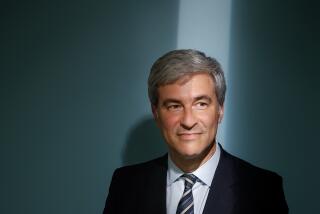MOCA announces balanced budget plan
Leaders of L.A.âs financially troubled Museum of Contemporary Art said Friday that they have crafted a balanced budget for the coming fiscal year -- but only by sacrificing four planned exhibitions and 17 more jobs, including two of seven curators. They hope that a fall exhibition drawn solely from MOCAâs acclaimed collection of post-World War II art will be a blockbuster and signal that the museumâs turnaround from last yearâs near-collapse is well underway.
âItâs a very gut-wrenching thing to go through all this . . . but we think weâve now gotten through a difficult time, and we are poised to shoot off full speed in the future,â said Charles E. Young, the former UCLA chancellor who became MOCAâs chief executive in December.
Young came on board after a tumultuous period in which the downtown museumâs deeply divided Board of Trustees considered merging with the Los Angeles County Museum of Art rather than take an up-by-the-bootstraps approach to restoring fiscal stability.
MOCA had run consistent deficits during the 1990s, siphoning money from its endowment to maintain a highly respected exhibition program.
Last fallâs global financial meltdown brought on MOCAâs moment of truth, as the endowment that totaled $38 million in 2000 tanked to a low of $5 million by yearâs end.
Eli Broad, L.A.âs leading arts philanthropist and one of MOCAâs founders, stepped in with a pledge of $15 million in operating support over five years, plus a dollar-for-dollar match, up to $15 million, of funds MOCA raises to replenish its endowment.
But two of Broadâs key conditions were setting a ceiling on spending and putting greater emphasis on showing MOCAâs own collection. Among the canceled shows is an exhibition of work by Thom Mayneâs Santa Monica architectural firm Morphosis.
Employees have paid a price: In cutting its budget from $20 million to the coming yearâs $15.5 million, MOCA has pared its staff from 159 positions at the start of this year to 119, only 61 of them full time. Brooke Hodge, curator of architecture and design, was laid off, along with an assistant curator. Senior staffers will have their pay cut at least 5%; others will have their hours or salaries reduced; and benefits are being cut for all employees.
To balance the budget, Young said, MOCA expects to raise about $11 million in donations -- on top of the $3 million Broad is giving annually for operations -- with earnings from admissions and sales accounting for the rest. If projections hold, he said, the museum will take in $16.5 million, with the surplus being funneled back into the endowment.
The board is being rebuilt as well after absorbing nine resignations since September. MOCA announced two new trustees: investment executive Marc I. Stern, who chairs the board of Los Angeles Opera, and Carolyn Powers, who has been a supporter of the Music Center.
Young, 77, has already said heâll step down by yearâs end or mid-2010 at the latest, so the board is also faced with seeking and hiring a director to succeed Young and Jeremy Strick, who was ousted in December after a 10-year tenure, then quickly hired to lead the Nasher Sculpture Center in Dallas.
By fall, MOCAâs leaders hope, the pain will have given way to the fizz of champagne: Broad said Friday that he and Los Angeles art collector Maria Bell will co-chair a Nov. 14 gala kicking off âCollection: The First 30 Years,â the first exhibition to offer a chronological showcase of the museumâs holdings, which number more than 6,000 works and feature pieces by a whoâs who of contemporary art that includes Andy Warhol, Robert Rauschenberg, David Hockney and Jackson Pollock.
The exhibition will initially take up all of MOCAâs main building on Grand Avenue near Walt Disney Concert Hall, as well as much of the Geffen Contemporary, the cavernous converted warehouse in Little Tokyo that has been closed since January to save money.
Tom Unterman, co-chairman of MOCAâs board, said the cuts in staffing and exhibitions were approved unanimously at a meeting Thursday.
Broad said he attended and saw âno contention, unlike the meetings late last yearâ when the trustees were riven over whether to punt by accepting LACMAâs merger offer, or stay in the game on their own. âPeople are sad theyâre having to cut things. Itâs no fun, but itâs the right thing to do.â
--
More to Read
The biggest entertainment stories
Get our big stories about Hollywood, film, television, music, arts, culture and more right in your inbox as soon as they publish.
You may occasionally receive promotional content from the Los Angeles Times.











